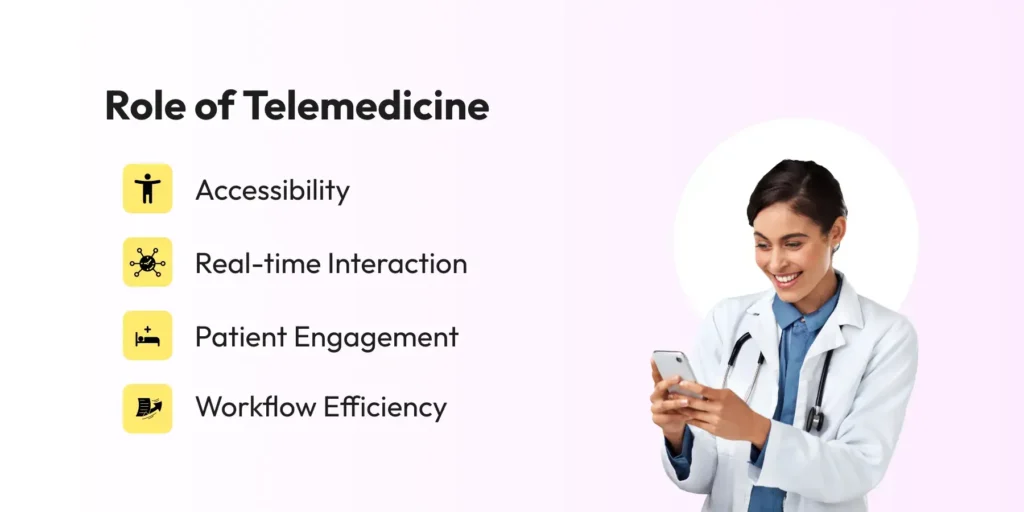The Role of Telemedicine Services in Healthcare

Telemedicine is the practice of providing healthcare facilities remotely through telecommunications technology. Telemedicine services have emerged as a transformative force in modern healthcare as it impacts various aspects of healthcare delivery, including:
- Accessibility
- Real-time Interaction
- Patient Engagement
- Workflow Efficiency
Let’s have a look at how Telemedicine services impact all aspects of healthcare in detail.
a. Accessibility and Reach
One of the biggest advantages of telemedicine is that it breaks down the geographical barriers to bring healthcare services to every individual, regardless of their location.
This is life-saving for rural areas where access to healthcare facilities is limited. Telemedicine enables patients to consult with specialists located far away, reducing the need for travel and other associated expenses.
At the same time, telemedicine also enables healthcare providers to extend their reach beyond traditional clinic settings, reaching patients in their homes or workplaces.
It also enables them to go beyond traditional medical care to encompass mental health counseling, therapy, and wellness coaching.
In short, telemedicine facilitates expanded accessibility which ensures that every individual irrespective of their location gets access to timely medical care.
b. Real-Time Interaction and Patient Engagement
Communication in healthcare is essential. Telemedicine facilitates exactly this with real-time interaction between patients and healthcare providers, resulting in a more immediate and responsive healthcare experience.
Patients can connect with healthcare professionals through video conferencing, instant messaging, or virtual consultations, eliminating the need for in-person visits for certain conditions.
Not only this, but telemedicine platforms also come with features such as appointment reminders, medication alerts, and health-tracking tools, further empowering patients to manage their health proactively.
In some instances, if the communication in healthcare isn’t quick, it can have fatal repercussions. That’s exactly where Telemedicine comes into the picture as it plays a crucial role in emergency response and disaster management by enabling remote triage, medical consultations, and care coordination during crises.
In emergency situations, such as natural disasters or pandemics, telemedicine helps alleviate strain on healthcare facilities, facilitates timely medical interventions, and ensures continuity of care for affected populations.
c. Streamlined Workflow and Efficiency
Telemedicine makes the lives of both healthcare professionals and patients easier. Patients enjoy reduced wait times as virtual consultations can often be scheduled more quickly than traditional in-person visits.
Whereas, healthcare professionals maximize their potential along with managing their schedules via virtual consultations and in-person appointments.
Telemedicine also improves coordination and collaboration among healthcare professionals by facilitating seamless communication.
Healthcare professionals can also offer personalized care delivery to the patient with the help of digital health records and telemonitoring devices.
Definition: Telemedicine refers to the remote diagnosis and treatment of patients using telecommunications technology.
Importance:
- Accessibility: Provides healthcare access to remote or underserved areas.
- Convenience: Allows patients to receive care from home, reducing travel time and costs.
- Efficiency: Streamlines healthcare delivery, reducing waiting times and improving resource allocation.
- Continuity of Care: Enables ongoing monitoring and follow-up without in-person visits.
Using the WhatsApp API in healthcare and telemedicine can significantly enhance communication, patient engagement, and operational efficiency. Here are eight prominent use cases:
Appointment Reminders and Scheduling:
- Appointment Reminders: Automated reminders can be sent to patients, reducing no-show rates and improving scheduling efficiency.
- Scheduling: Patients can book appointments directly through WhatsApp, integrating with the healthcare provider’s scheduling system.
Health Monitoring and Alerts:
- Medication Reminders: Automated messages can remind patients to take medications or follow specific health regimens.
- Health Alerts: Provide real-time health alerts or updates, such as test results or changes in treatment plans.
Teleconsultation and Remote Diagnosis:
- Virtual Consultations: Conduct secure video consultations or chat-based consultations via WhatsApp.
- Remote Diagnosis Support: Exchange photos, videos, or descriptions securely to aid in remote diagnosis.
Patient Education and Support:
- Health Tips: Share educational content, such as tips for managing chronic conditions or promoting healthy habits.
- FAQs and Information: Provide answers to frequently asked questions about treatments, procedures, or healthcare policies.
Emergency Notifications:
- Critical Alerts: Send emergency notifications to healthcare providers or caregivers in urgent situations.
- Emergency Contact: Enable patients to reach out quickly during emergencies for immediate assistance.
Follow-up Care and Post-Discharge Support:
- Post-Appointment Follow-ups: Send follow-up instructions or check-ins after appointments.
- Post-Discharge Instructions: Share post-discharge care instructions or rehabilitation guidelines.
Billing and Administrative Notifications:
- Billing Information: Send billing reminders or notifications about insurance claims.
- Administrative Updates: Notify patients about administrative updates, such as policy changes or new services.
Health Campaigns and Surveys:
- Health Campaigns: Run health awareness campaigns via broadcast messages.
- Patient Surveys: Gather patient feedback or conduct satisfaction surveys to improve service quality.
These use cases leverage WhatsApp’s popularity, ease of use, and accessibility to enhance patient care, streamline communication, and improve overall healthcare outcomes in both traditional and telemedicine settings.

